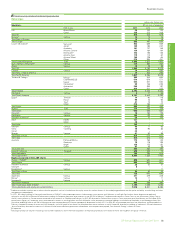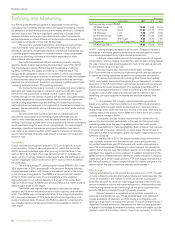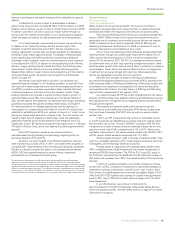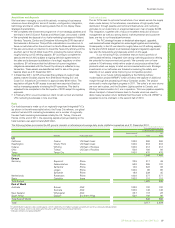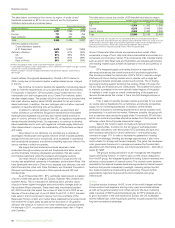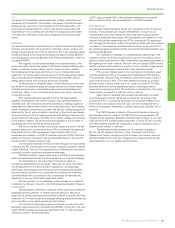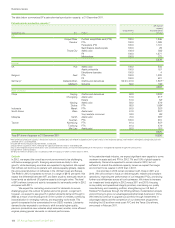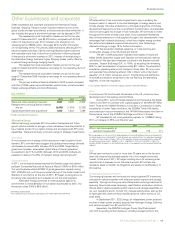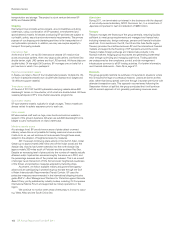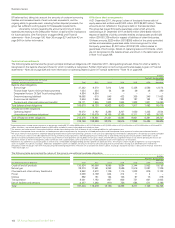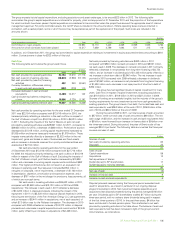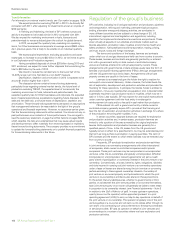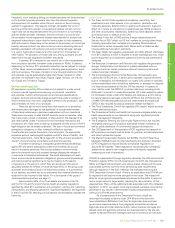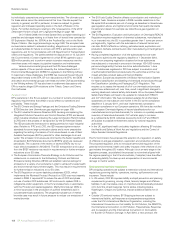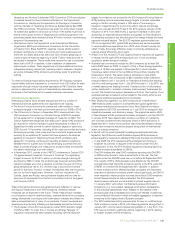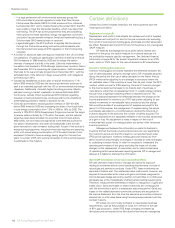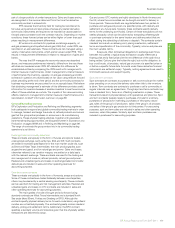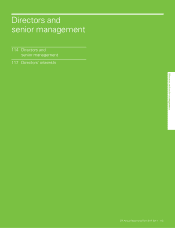BP 2011 Annual Report Download - page 105
Download and view the complete annual report
Please find page 105 of the 2011 BP annual report below. You can navigate through the pages in the report by either clicking on the pages listed below, or by using the keyword search tool below to find specific information within the annual report.
BP Annual Report and Form 20-F 2011 103
Business review: BP in more depth
Business review
Liquidity and capital resources
Following the Deepwater Horizon oil spill in 2010, the group initially faced
significant costs relating to the immediate response activities as well as
significant uncertainty regarding the ultimate magnitude of its liabilities and
timing of cash outflows. During 2011 the impact on the group’s liquidity
and capital resources has stabilized, allowing steps to be taken to enhance
the strength of the balance sheet.
The group’s long-term credit ratings are A (stable outlook) from
Standard & Poor’s, strengthened from A (negative outlook) in July 2011,
and A2 (stable outlook) from Moody’s Investor Services.
BP renegotiated its committed bank facilities during 2011 putting in
place $6.9 billion of facilities with 25 international banking counterparties,
mostly for a term of three years. In addition the group has increased
its access to commercial bank letters of credit (LC) by putting in place
committed LC facilities of $5.1 billion and secured LC arrangements of $2.2
billion, to supplement its uncommitted and unsecured LC lines.
The disposal programme of $30 billion initially announced in 2010
has been increased to $38 billion, for completion by the end of 2013. By
the end of 2011 agreements had been signed for more than $21 billion,
with cash receipts totalling $17 billion in 2010 and $2.7 billion in 2011.
BP accessed US and European capital markets throughout the year
with bond issuances amounting to $10.7 billion in 2011.
A further $0.8 billion of US Industrial Revenue/Municipal bonds
were re-issued in term-out mode of between three to 10 years during
the year.
During 2011 BP repaid $2.9 billion of the $5.3 billion of borrowings
raised in 2010 that were secured against working capital and other assets,
or backed by future crude oil sales from BP’s interests in specific offshore
Angola and Azerbaijan fields.
Financial framework
BP continues to refine its financial framework to support the pursuit of
value growth for shareholders, while maintaining a secure financial base.
BP intends to increase operating cash flowa by 50% in 2014 compared to
2011b. Half of the increase will arise as the remaining payments into the
Deepwater Horizon Oil Spill Trust fund complete by the end of 2012, and
half from operations. BP plans to use half of the expected additional cash
flows to increase investments and half for other purposes.
We intend to maintain a significant liquidity buffer and to reduce our
net debt ratio to the lower half of the 10-20% gearing range over time. See
Financial statements – Note 35 on page 230 for gross debt, which is the
nearest equivalent measure to net debt on an IFRS basis, and for further
information on net debt and net debt ratio.
a Operating cash flow is net cash provided by (used in) operating activities, as stated in the group
cash flow statement on page 181.
b Assuming an oil price of $100 per barrel in 2014. The projection reflects our expectation that all
required payments into the $20-billion trust fund will have been completed by the end of 2012.
It does not reflect any cash flows relating to other liabilities, contingent liabilities, settlements or
contingent assets arising from the Gulf of Mexico oil spill which may or may not arise at that time.
See Financial statements – Note 43 on page 249, for further information on contingent liabilities.
Dividends and other distributions to shareholders
On 1 February 2011, BP announced the resumption of quarterly dividend
payments, with a fourth-quarter 2010 dividend of 7 cents per share. The
resumption followed the suspension of dividend payments for the first
three quarters of 2010 announced in June 2010 in light of the Deepwater
Horizon oil spill and commitments to fund the $20-billion Trust. The same
level of dividend was maintained for the first three quarters of 2011.
The total dividend paid to BP shareholders in 2011 was $4.1 billion
with shareholders also having the option to receive a scrip dividend,
compared with $2.6 billion paid in 2010. The dividend is determined in US
dollars, the economic currency of BP.
On 7 February 2012, BP announced a dividend of 8 cents per share
in respect of the fourth quarter 2011.
During 2011 and 2010, the company did not repurchase any of
its own shares. Details of purchases to satisfy requirements of certain
employee share-based payment plans are set out on page 170.
Financing the group’s activities
The group’s principal commodity, oil, is priced internationally in US dollars.
Group policy has generally been to minimize economic exposure to
currency movements by financing operations with US dollar debt. Where
debt is issued in other currencies, including euros, it is generally swapped
back to US dollars using derivative contracts, or else hedged by maintaining
offsetting cash positions in the same currency. The overall cash balances
of the group are mainly held in US dollars or swapped to US dollars and
holdings are well-diversified to reduce concentration risk. The group is not
therefore exposed to significant currency risk, such as in relation to the
euro, regarding its borrowings. Also see Risk factors on page 59 for further
information on risks associated with the general macroeconomic outlook,
including the stability of the eurozone and Financial statements – Note 26
on page 217.
The group’s finance debt at 31 December 2011 amounted to $44.2
billion (2010 $45.3 billion). Of the total finance debt, $9.0 billion is classified
as short term at the end of 2011 (2010 $14.6 billion). The short-term
balance includes $4.9 billion for amounts repayable within the next 12
months relating to long-term borrowings (2010 $6.9 billion). Commercial
paper markets in the US and Europe are a further source of short-term
liquidity for the group to provide timing flexibility. At 31 December 2011,
outstanding commercial paper amounted to $3.6 billion (2010 $1.0 billion).
Also included within short-term debt at the end of 2010 was $6.2 billion
relating to deposits received for announced disposal transactions still
pending legal completion post the balance sheet date. At the end of 2011
the balance was de minimis at $30 million.
We have in place a European Debt Issuance Programme (DIP)
under which the group may raise up to $20 billion of debt for maturities
of one month or longer. At 31 December 2011, the amount drawn down
against the DIP was $11.6 billion (2010 $12.3 billion). In addition, the group
has in place an unlimited US shelf registration statement under which it
may raise debt with maturities of one month or longer. None of the capital
market bond issuances since the Deepwater Horizon oil spill contain any
additional financial covenants compared with the group’s capital markets
issuances prior to the incident.
The maturity profile and fixed/floating rate characteristics of the
group’s debt are described in Financial statements – Note 34 on page 229.
Net debt was $29.0 billion at the end of 2011, an increase of $3.1
billion from the 2010 year-end position of $25.9 billion. The ratio of net
debt to net debt plus equity was 20.5% at the end of 2011 (2010 21.2%).
Net debt and the ratio of net debt to net debt plus equity are non-GAAP
measures. We believe that these measures provide useful information to
investors. Net debt enables investors to see the economic effect of gross
debt, related hedges and cash and cash equivalents in total. The net debt
ratio enables investors to see how significant net debt is relative to equity
from shareholders. See Financial statements – Note 35 on page 230 for
gross debt, which is the nearest equivalent measure on an IFRS basis, and
for further information on net debt.
Included in net debt are cash and cash equivalents of $14.1 billion
at 31 December 2011 (2010 $18.6 billion). BP manages its cash position
to ensure the group has adequate cover to respond to potential short-term
market illiquidity, and expects to maintain a strong cash position. Cash
balances are pooled centrally where permissible, and deployed globally
as required. Cash surpluses are deposited with creditworthy banks and
money market funds with short maturities to ensure availability. The
group holds $1.2 billion of cash outside the UK and it is not expected
that any significant tax will arise on repatriation. Further information on
the management of liquidity risk and credit risk is provided in Financial
statements – Note 26 on pages 217-222, and on the cash position in
Financial statements – Note 30 on page 223.
The group also has access to significant sources of liquidity in the
form of committed bank facilities. At 31 December 2011, the group had
available undrawn committed standby borrowing facilities of $6.9 billion
(2010 $12.5 billion), made up of:
• $6.8 billion of standby facilities available to draw and repay by mid-March
2014.
• 625 million Chinese yuan ($0.1 billion) of 365-day standby facilities
available to draw and repay until the second half of 2012.
During 2011 $7.2 billion of 364-day facilities expired and were not renewed.


